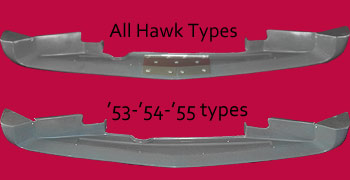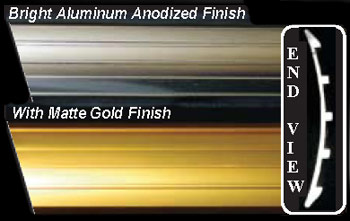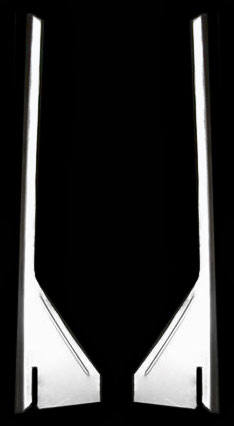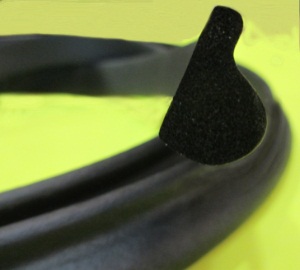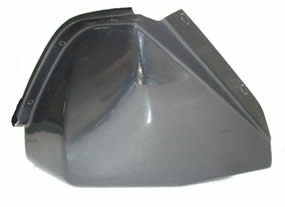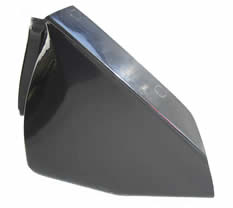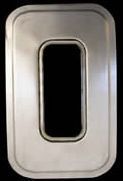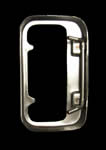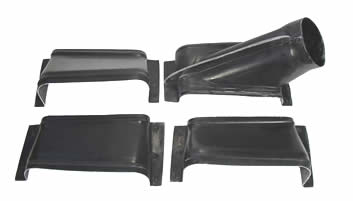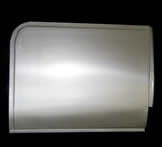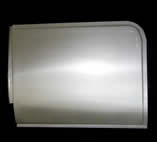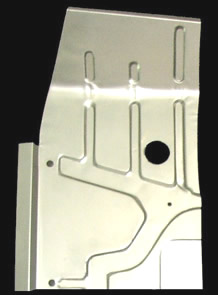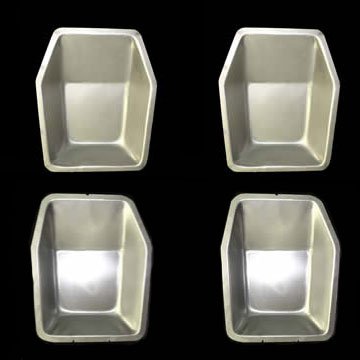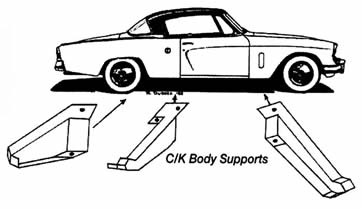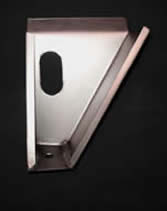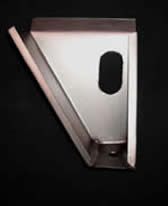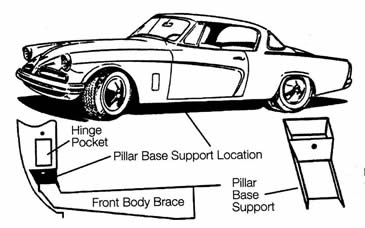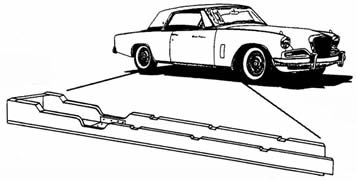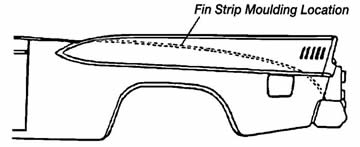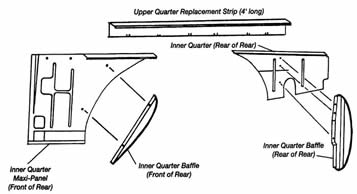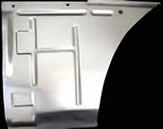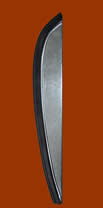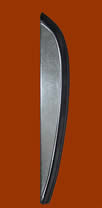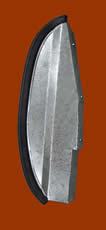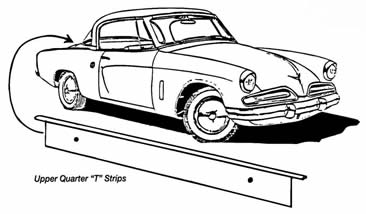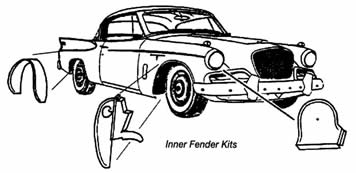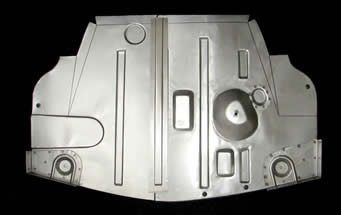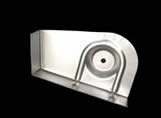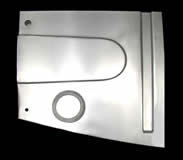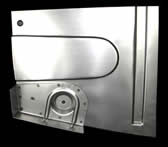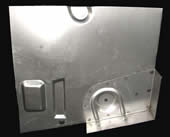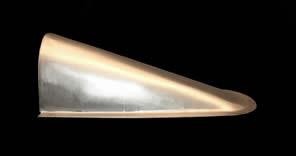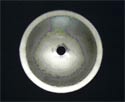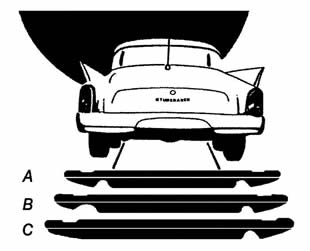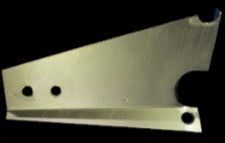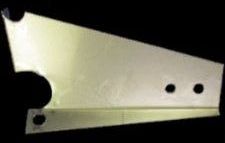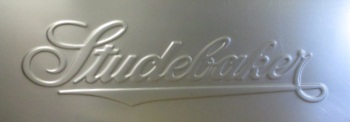1953- 1964 Studebaker CK Coupes & Hawks
Floor
Front Area
Side and Cowl Area
Supports
Tail/Rear Area
Wheel Area
Other
All
Gifts and Misc.
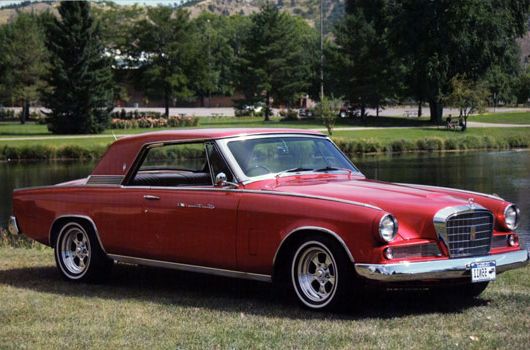
Rocker Panel
Our rocker panels have pre-formed weatherstrip channels and are properly arched from front to rear just like the originals which will allow for the maintenance of proper body shape, proper door fit, and general ease of installation. Made of original gauge steel.
- None of our panels are cosmetically coated. Click here to find out why.
- Made in the USA
$195.00 pair
Inner Rocker Panel
Rocker panels on all types were stabilized by an inner rocker which spans from the floor threshold to the lower edge of the rocker panel and rear quarter panel.
- None of our panels are cosmetically coated. Click here to find out why.
- Made in the USA
$70.00 Pair '53-'61 Inner rocker
$70.00 Pair '62-'64 Inner rocker GT type
Front Lower Air Deflector
We now have a very good quality product reproduced in sturdy fiberglass that is steel reinforced at the radiator bracket area attachment point on all types.
All Hawk types-'56 to '64 are specifically reinforced by a steel plate inbedded well beyond the hood latch area. A detachable hood latch plate is provided for hood latch retainer attachment.
- None of our panels are cosmetically coated. Click here to find out why.
- Made in the USA
$390.00 "53-55"
$420.00 "56-"64 All Hawks
GT Hawk Aluminum Rocker Moldings
Both types are intended for 1962-1963 and 1964 GT types but will fit all CK’s from 1953 to 1964. They can also be special ordered for all 1953-1960 sedan types to give your car a very distinct and classy look.
Our GT Rocker Moldings are pre-drilled and include proper screws and installation instructions.
Bright Anodized Aluminum Finish
$350.00 Set
More Information and Add to Cart Options
Matte Gold Finish
$475.00 Set
Anti-Kink Hood Stiffeners
Gives greater strength to a notoriously kink prone area on all '53-'64 Coupes and Hawks and some '53-'58 sedan types. Our design is shaped to your hood edge contour and will reinforce the kink prone areas for a length of 23 inches.
Preferred attachment is via plug welds along the outside hood lip. Pop-rivets, automotive adhesive or a combination of both is used by some installers. Remember that it is always a wise precaution to install our anti-kinks whenever doing a restoration or a paint job.
Installation instructions will be included with your purchase.
- None of our panels are cosmetically coated. Click here to find out why.
- Made in the USA
$85.00 Pair
More Information and Add to Cart Options
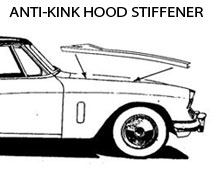
Cowl/Hood Seal
$55.00 Cowl/Hood Seal (With Adhesive)
Splashguard
CK brake & clutch pedal, dimmer switch & master cylinder splash guard for all '53-'64 Coupe/Hawk types.
A very nicely done reproduction in fiberglass which reduces road noise & will never rust out. (Driver Side only.)
$135.00 each
Lower Door Skins
Our door skin is approximately 5"H x full length. Forward and bottom edges rolled as original. Rear edge left open to allow for proper installation. Upper edge is flanged for a flush fit.
- None of our panels are cosmetically coated. Click here to find out why.
- Made in the USA
$55.00 Driver
$55.00 Passenger
Front Fender Patch
- None of our panels are cosmetically coated. Click here to find out why.
- Made in the USA
$95.00 Driver each
$95.00 Passenger each
Vent Patch
- None of our panels are cosmetically coated. Click here to find out why.
- Made in the USA
$85.00 Vent Patch
Hinge and Shroud Collar
- None of our panels are cosmetically coated. Click here to find out why.
- Made in the USA
$85.00 each
Vent Patch and Hinge
& Shroud Collar Attached
Vent Patch and Hinge & Shroud Collar Attached
Both products are securely spot welded together which will allow for faster installation. (Can be special ordered without perimeter flange).
- None of our panels are cosmetically coated. Click here to find out why.
- Made in the USA
$185.00 each
Vent Shrouds
Our shrouds are reproduced in rust-proof fiberglass. Original appearance is maintained. Set of 4 pieces.
$135.00 Per Car
Rear Fender Patch Panel
- None of our panels are cosmetically coated. Click here to find out why.
- Made in the USA
$55.00 Driver each
$55.00 Passenger each
$110.00 Pair
Floor Panels
Our Floor Panels are 22" wide and extend from the firewall seam to the rear seat riser in length. Our die stamped panel is manufactured in heavy 18 gauge steel and now includes the seat anchor plates pre-attached. Note that our Floor Panel thresholds are properly formed and are arched front to rear just like the original floor panel which will allow for proper Rocker Panel placement and the maintenance of original body shape and proper door fit upon completion.
Note also that we have paid close attention to original indent detail which is necessary for a proper repair or restoration. We have used original Studebaker archive prints in order to achieve a high degree of accuracy in our product.
'53-'61 Floor Panels are shown at right, pre-bend.
GT Types will have two rectangular stampings toward the rear of each panel instead of the elongated shape shown at the rear of each panel shown on the right.
- None of our panels are cosmetically coated. Click here to find out why.
- Made in the USA
$250.00 Driver
$250.00 Passenger
$480.00 Pair
Mini Panels (Front only)
The length goes from the firewall seam to midpoint of front seat as shown. Width 22". All panels are produced in heavy 18-gauge steel, as was the original. Driver side shown. Both sides available.
- None of our panels are cosmetically coated. Click here to find out why.
- Made in the USA
$185.00 Driver
$185.00 Passenger
$370.00 Pair
Master Cylinder and Gas Tank
Sender Access Cover
Die formed in 18-gauge steel. 4" Diameter.
- None of our panels are cosmetically coated. Click here to find out why.
- Made in the USA
$8.00 each
Rear Floor Panel
Now die formed for improved fit and proper appearance. Our rear panel is 16" wide, and fits directly under the rear seat. Extra material at the end of the panel may be rolled up as needed.
- None of our panels are cosmetically coated. Click here to find out why.
- Made in the USA
$85.00 Driver
$85.00 Passenger
$160.00 Pair
Rear Passenger Footwells
Footwells are produced in heavy 18-gauge steel, and are properly die formed.
- None of our panels are cosmetically coated. Click here to find out why.
- Made in the USA
'53-'57 Types
$115.00 Driver
$115.00 Passenger
$230.00 Pair
More Information and Add to Cart Options
'58-'64 Types$115.00 Driver
$115.00 Passenger
$230.00 Pair
Body Supports
Body Supports
Our body supports are accurately reproduced in steel heavier than the original. Your original supports may be rusted out or "thinned" or sprung. Thus, your car may be too "flexible" to allow for proper door fit or proper structural rigidity. Installation of new supports is generally a very wise decision during any restoration.
- None of our panels are cosmetically coated. Click here to find out why.
- Made in the USA
Front Body Supports
$190.00 Driver
$190.00 Passenger
More Information and Add to Cart Options
Middle Body Supports$180.00 Driver
$180.00 Passenger
More Information and Add to Cart Options
Rear Body Supports$160.00 Driver
$160.00 Passenger
Firewall Support
- 14 Gauge Steel
- 8 1/2" High
- None of our panels are cosmetically coated. Click here to find out why.
- Made in the USA
$45.00 Driver
$45.00 Passenger
Pillar Base Supports
1953-1963 Studebaker CK Coupe and Hawk
The most critically stressed portion of your Studebaker body is the front pillar base area. This area is usually the most seriously weakened part of your car body, being the first area of the floor to rust out. If the pillar base area has disintegrated, the body brace and pillar wing may be supporting nothing.
- None of our panels are cosmetically coated. Click here to find out why.
- Made in the USA
$35.00 Driver
$35.00 Passenger
Studebaker CK Sub-Floor Torque Boxes
GT Types Only
The purpose of the torque boxes was to add rigidity to the car body. The boxes attach along the length of the rocker area and also to the underside of the floor panel. Each end is to be capped by body supports which can be ordered separately.
We produce a quality die formed product which maintains original strength and appearance. Produced in original gauge steel.
- None of our panels are cosmetically coated. Click here to find out why.
- Made in the USA
$250.00 Driver
$250.00 Passenger
$450.00 Pair
Fin Strip Moldings
Fin strip moldings cover the seam between the original fin overlay and the trunk lid area. We have an exact duplicate of the original that is now Pre Curved at the forward end which will make your installation much easier.
$195.00 Pre Curved Pair
$35.00 Nut and Bolt Pack - Per Car
Layout of Upper Quarter Replacement Strip, Forward Inner Quarter and Inner Fender Baffles
Upper Quarter Replacement Strip
Often the upper portion of the inner quarter rusts because of water intrusion. Our properly curved strip is intended to repair the upper area where the rear fender is bolted to the body.
- 4' long X 3 1/4" high
- None of our panels are cosmetically coated. Click here to find out why.
- Made in the USA
$45.00 each
Front of Rear Wheel Inner Quarter Panel
- Die Formed
- None of our panels are cosmetically coated. Click here to find out why.
- Made in the USA
$95.00 Driver
$95.00 Passenger
More Information and Add to Cart Options
Front of Rear Wheel Lower Inner Quarter Repair Clips
- Die Formed
- 18 Gauge Steel
- 10 Inches High
- None of our panels are cosmetically coated. Click here to find out why.
- Made in the USA
$55.00 Driver
$55.00 Passenger
Front of Rear Wheel Inner Quarter Baffles
- None of our panels are cosmetically coated. Click here to find out why.
- Made in the USA
$45.00 Driver
$45.00 Passenger
Rear of Rear Wheel Gas Filler Tube Protecter Baffle
- None of our panels are cosmetically coated. Click here to find out why.
- Made in the USA
$55.00 Driver Side Only
Upper Quarter "T" Strip
"T" strips are intended to hide the seam between the upper quarter panel and the rear quarter window, as was original.
- None of our panels are cosmetically coated. Click here to find out why.
- Made in the USA
$20.00 each
Inner Fender Kits
10-piece fender kit is developed to fit all '53 or later Coupes & Hawks.
- Formed in 20 gauge steel.
- Instructions included.
- None of our panels are cosmetically coated. Click here to find out why.
- Made in the USA
$195.00 Complete Kit
More Information and Add to Cart Options
Full Trunk Panel With Corner Supports
Our CK trunk floor includes the stiffener rib. Trunk floor corner supports are spot welded into place.
Our panel is made in two pieces to more easily facilitate frame-on installation. (The center joiner strip will conceal the joint which is slightly to the left of center.) Note also that the black lines shown on the panel indicate areas to be trimmed off if not needed or cut & rolled up if needed.
- None of our panels are cosmetically coated. Click here to find out why.
- Made in the USA
$385.00 each
Trunk Floor Corner Supports
Made of steel which is heavier than the original. (Note, the amount of shim used between the frame and the trunk floor corners can be used to adjust door fit.) Outside 90o up turned bends are now rounded for a more authentic appearance.
- None of our panels are cosmetically coated. Click here to find out why.
- Made in the USA
$55.00 Driver
$55.00 Passenger
Trunk Floor Corner Patches
Corner patches measure 19"wide by 18" long. You'll need to cut out the filler tube area of the driver side panel if the original type gas filler tube is used.
- None of our panels are cosmetically coated. Click here to find out why.
- Made in the USA
$80.00 Driver
$80.00 Passenger
Trunk Floor Corner Patches
With Corner Supports Attatched
Components securely spot welded together. Size is approximately 19" wide X 18" long. (The customer must cut out the filler tube area of the driver side panel if the original type gas filler tube is used.) Redesigned corner supports are now used.
- None of our panels are cosmetically coated. Click here to find out why.
- Made in the USA
$135.00 Driver
$135.00 Passenger
$270.00 Pair
Gas Filler Tube Cover
- Die Formed
- None of our panels are cosmetically coated. Click here to find out why.
- Made in the USA
$45.00 each
Trunk Latch Retainer
Replace your bent or damaged trunk latch retainer with our replacement, die formed in 14-gauge steel.
- None of our panels are cosmetically coated. Click here to find out why.
- Made in the USA
$25.00 each
Spare Tire Hold Down Washer
- 6"
- None of our panels are cosmetically coated. Click here to find out why.
- Made in the USA
$15.00 Spare Tire Washer Hold Down
Weather Strips and Deck Lid Repair
Lower Rear Deck Lid Repair Strip
Side and bottom are rolled as original. Dimensions = full width x 1" high. Back-up strip included, 2 1/2" high.
- None of our panels are cosmetically coated. Click here to find out why.
- Made in the USA
$45.00 each
More Information and Add to Cart Options
Trunk Weather-Strip Channels
Both Forward the and the Side Weather Strip Channels are curved which makes for a much easier installation.
- None of our panels are cosmetically coated. Click here to find out why.
- Made in the USA
$35.00 Front
$35.00 Driver Side
$35.00 Passenger Side
More Information and Add to Cart Options
Universal Straight Length Weatherstrip 20 inches long
$25.00 Each
More Information and Add to Cart Options
Rear Weather Strip Channel
Manufactured in original gauge steel. Now completely die formed and vastly improved via new tooling which makes installation easier. (Full width X 7" high as was original.)
- None of our panels are cosmetically coated. Click here to find out why.
- Made in the USA
$85.00 each
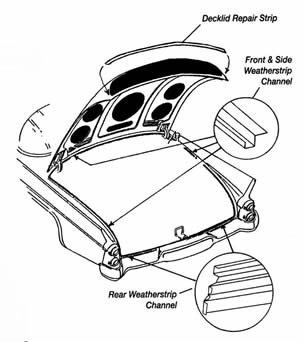
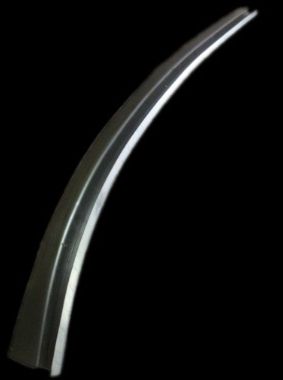
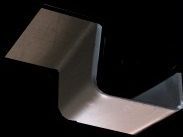
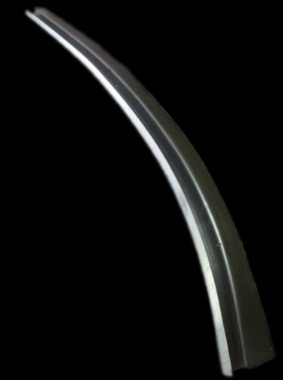
Close Up Of End

Body to Rear Bumper Horizontal Splash Guard
A very good reproduction in good quality fiberglass.
- None of our panels are cosmetically coated. Click here to find out why.
- Made in the USA
$110.00 each
Lower Rear Bumper Valance
Gravel Deflector
Very good quality valances are reproduced in carefully molded fiberglass.
Rust and corrosion don't stand a chance!
Order type A, B, or C
- None of our panels are cosmetically coated. Click here to find out why.
- Made in the USA
$110.00 "A" Type
$110.00 "B" Type
$110.00 "C" Type
More Information and Add to Cart Options
Exhaust Hanger Bracket
- None of our panels are cosmetically coated. Click here to find out why.
- Made in the USA
$35.00 Exhaust Hanger Driver
$35.00 Exhaust Hanger Passenger
$70.00 Exhaust Hanger Pair
Studebaker Script Stamped Panel
- None of our panels are cosmetically coated. Click here to find out why.
- Made in the USA
$250.00 Script Stamping
A Classic Studebaker Commercial
Whenever one of the buff books runs a "most beautiful cars of all time" feature, or someone puts out a big honkin' coffee-table book on the subject, the car we will be looking at today usually makes the list, alongside such lovelies as prewar Talbots and Bugattis, boat-tail Auburns and Cord 810s, curvaceous Italian sports cars, E-type Jaguars and 1961 Lincoln Continentals. We could debate which of them is the absolute loveliest all day and into the night and halfway through tomorrow's breakfast and never settle the question, but I would submit that today's subject stands out from the rest of this elite category in one respect.
A prewar Bugatti or a Cord looks like something from the 1930s--beautiful, yes, but clearly a creation of a particular era. Likewise, the Ferraris and Maseratis on the list, they all have that late-60s-early-70s groovy-mod jet-set thing going on. The E-type is clearly a product of the late 50s and early 60s, while the Continental's styling practically screams "Kennedy administration!"
In contract to these, today's subject isn't quite so obviously tied to a particular year. It was designed as a show car and was clearly "ahead of the curve" when it rolled out nearly 60 years ago--and if it's not quite "ahead of the curve" today, that's only because the "curve" may have finally caught up with it. Take out the triangular vent windows, dial back on the chrome, give it headrests, three-point seatbelts, cupholders, and power remote mirrors, slap on a Honda or Toyota badge, and you could plausibly pass it off as a 2010 model.
Ladies and gentlemen, fellow Car Lusters of all ages, I give you the stunningly beautiful Studebaker "Loewy Coupes," the 1953-54 Starlight and Starliner:
The "Loewy coupe" nickname is, obviously, a reference to Raymond Loewy, whose studio did much of Studebaker's styling and designed everything else from soft drink bottles to locomotives to the paint scheme for Air Force One. While the Loewy coupes were indeed a product of the Loewy & Associates design studio, they weren't styled by Mr. Loewy himself. By the time the talented Mr. Loewy reached his greatest fame in the middle years of last century he was not really a designer anymore, he was mainly a promoter of the designs done by his staff--even though contemporary press coverage and advertising usually gave him all the credit.
Loewy's relationship with Studebaker began in the late 1930s, with the design of the 1939 Champion. The actual designing was done by Virgil M. Exner, Sr., who was then an employee of Loewy & Associates. This design remained in production into the abbreviated 1942 model year. When civilian auto production resumed after the war, Studebaker, like all the other established manufacturers, dusted off the stored tooling for the '42s and put them back in production as 1946 models.
For 1947, Studebaker rolled out an all-new "envelope body" design. The rear quarters had shallow bulges that suggested fenders, and the hood had a "postwar nose" that recalled the prewar narrow hood, but as you can see from the ad on the right, we've definitely gotten away from prewar styling. Studebaker's advertising proudly proclaimed that it was "First by far with a postwar car!" ("Dutch" Darrin, the stylist who did the 1947 Kaisers and Frazers, might argue that he got there ahead of Studebaker, but the boys from South Bend had still beaten all of the other manufacturers by a year or more in the race to introduce flashy new postwar styling.) Though the design was attributed to Loewy, it was once more Virgil Exner (now employed in-house at South Bend after a falling-out with Loewy) who had done the actual work--he's listed as the inventor on the design patent!
The '47 Stude body stayed in production until 1952. The "front clip"--the outer body forward of the cowl--was restyled twice over the course of production. The 1950 revision by Robert Bourke, the chief designer at Loewy & Associates, gave the world the iconic "bullet nose" made famous as Fozzie Bear's ride in The Muppet Movie. Bullet-nosed Studes are certainly a worthy subject for Car Lust, but for purposes of the present discussion, the 1952 version is more significant.
The '52 restyling produced a more conventional-looking "postwar nose" atop a chrome grille, with the headlights in chrome bezels on either side. The lines of the "nose" carried down the front of the car in a V-shape that split the grille in two. The upper molding on the grille flowed up from the "nose" in a slight curve, reminiscent of the bow wave kicked up by a ship under way. 1952 also saw the introduction of a hardtop version of the body design with a wraparound rear window, the "Starliner," which proved a strong seller.
After the 1952 Studes were finished, Bob Bourke sketched out a design for a new "Starliner" show car. It would not be an understatement to call that Mr. Bourke's best day at the office ever, because this car was absolutely drop-dead gorgeous.
Bourke's show car design had a family resemblance to the '52 Starliner: the nose, headlights, bow-wave grille openings, and the little cabin air vent hatch behind the front wheel were all still there. The proportions were radically different, though. The show car was longer, with a longer wheelbase (120.5" versus the 115" frame used on the '52), and lower--dramatically lower. The overall height was 56 inches, a good six inches to a foot less than everything else on the American roads that wasn't a British two-seater. Not only was it low, it was sleek, its smooth lines and sloped hood in sharp contrast to the generally squared-up and flat-faced look then in vogue. At a time when American styling was trending toward more and more chrome, it had restrained ornamentation, so that it managed to be both dramatic and understated at the same time.
Most important, everything on the car was just the right size and shape relative to everything else. It all fit together. It worked in a way that few designs ever do.
Studebaker management loved the design. Absolutely loved it. They loved it so much they decided to put it into production as a 1953 model, pretty much exactly as Bob Bourke had sketched it. They also decided to restyle the company's sedans to match the coupe.
It was at this point that Studebaker ran into a few problems, and made a few costly mistakes. The coupe was engineered with a very light frame. The prototype fit together perfectly--until they installed an engine. The weight of the engine block flexed the frame enough that the front end no longer lined up correctly. This was eventually corrected, but production was delayed by several weeks, and even after the fix the new Starliner was a little too flexible for its own good, with a tendency to develop squeaks and rattles. In response to this, Studebaker developed a variation on the design called the "Starlight," which had a pillar behind the door and a fixed rear quarter window. The B-pillar compromised the purity of the design a bit, but stiffened the car body and cut down on the squeaks and rattles.
The sedans were another story entirely. The base sedans were built on a 116.5" frame, four inches shorter than the Starliner and Starlight. They were given a slightly higher roofline, which combined with the short wheelbase to cause them to look stubby compared to the coupes. The thickish window frames on the doors also made the whole greenhouse a little too heavy. Still, they're not bad looking cars by any means.
Studebaker's model lineup included a stretched sedan called the Land Cruiser. The '53 Land Cruiser used the coupe's 120.5" wheelbase, and as you can see from the photo below, the extra four inches gave it better proportions.
The 1953 Studes made their debut to rave reviews for their styling. The ads called them "The new American car with the European look." Some contemporary European cars--mostly Italian sports cars and the like--were low and clean-lined like the Studebakers, but most were no less tall and square than their Yankee counterparts, and quite a few were still holding on to prewar styling themes like separate fenders and narrow hoods. The "European look" Starlight and Starliner were as far ahead of most of Europe as they were of their Detroit competition.
The Loewy coupes came in two different "models" and two different trim levels. The Champion model series was powered by an 85 gross horsepower flathead straight six originally developed before the war. Champion Starlights, with the B-pillar, were available in "Deluxe" (middle) and "Regal" (top-of-the-line) trim levels; the pillarless Starliner was only available in Regal trim.
The more-expensive Commander model series was powered by Studebaker's overhead-valve V-8 introduced in 1951, the first modern V-8 developed by one of the "independent" car makers. In its 1953 version, this engine had a displacement of 232.6 cubic inches and produced 120 gross horsepower. It served Studebaker well--apart from a tendency toward minor oil leaks, it had no real vices, and it underwent steady improvements over the next decade, culminating in the supercharged R2 and R3 Avanti engines of 1963. As with the Champion series, you could get a Commander Starlight in either Deluxe or Regal trim, or go whole hog and splurge on a top-of-the-list Commander Regal Starliner. The only outward distinction between a Champion and a Commander is the badging on the hood and rear quarters--Champions have a stylized "S", while Commanders have a "V-8" device. The two models also had completely different dashboards.
Once they hit the showrooms, the coupes outsold the sedans nearly four to one, creating yet another problem for Studebaker. In setting its production schedules for the new model year, Studebaker had quite understandably assumed that the roomier and more practical sedans would outsell the racy coupes, as they had in 1952, and 1951, and, well, pretty much every year since the end of the war. The initial shortage of coupes, the production delays resulting from the stiffness issues with the Starlight, and the need to rejigger production schedules to match demand, undoubtedly cost the company some canceled orders and lost sales. The coupes also suffered from build quality problems, according to contemporary reviews. Still, Studebaker sold nearly 70,000 Loewy coupes (slightly less than half its total sales) in the 1953 model year.
It did not take long for those interested in high performance to take notice of the Loewy coupes. The Starlight and Starliner had light weight (from just under 2,700 pounds for a Champion Deluxe Starlight to a little over 3,100 for a Commander Regal Starliner), and a lower center of gravity and better aerodynamics than other cars. Actually, they're less aerodynamic than you might expect, with a drag coefficient of 0.40--the windshield is rather vertical, and the tail is too low--but given that nearly everything else available at the time was shaped like a streamlined brick with bumpers, the Loewys became the car of choice for stock-bodied salt flat speedsters and such.
For less extreme sporting use, Bill Frick, a car customizer on Long Island, offered the Studillac. This was a Starliner with the stock drivetrain replaced by a Cadillac V-8. The circa 1953 Caddy V-8 was a 331-cubic inch small-block producing 210 gross horsepower and 330 foot-pounds of torque in stock form, designed to overcome the inertia of five thousand pound dreadnought road barges. Drop that engine into a car that was about a ton lighter, and the result was an absolute screaming terror--around 8.5 seconds 0-60, at a time when 15 seconds would have been considered impressive. The price of a Studillac conversion was impressive, too--$1,500 ($11,500 in today's money) plus the cost of the donor Starliner (at least $2,115 back then, equivalent to $16,850 now). Mr. Frick built just under 300 "factory" Studillacs between 1953 and 1955, and many more Caddy engine swaps were performed by individual owners following along with the many "how to" articles in car magazines.
For 1954, the Starliner frame was stiffened, and the grille inserts were given an egg-crate treatment. The build quality issues had been solved, so one would have expected the Loewy coupes to continue selling strong. However, despite heavy promotion including TV ads, Studebaker's total sales for 1954 were only 68,708 vehicles--less than half of the previous year's figure.
Some have suggested that the problem was that Bob Bourke's design was too radical, too artistic, too pretty for the unsophisticated rubes in flyover country to appreciate. This theory appeals to a certain snobbish highbrow mentality, but it's not correct. The real problem was that 1954 was a really bad year to be an independent car manufacturer. Ford was engaged in a price war with GM at the low end of the market. Both manufacturers cut the price of Fords and Chevys and flooded dealerships with discounted iron, and the independents like Studebaker couldn't keep up. For example, the factory price of a bare-bones base-model 2-door Champion (6-cylinder) sedan was $1,758, which is $13,928 in today's dollars. That was a bit more than the factory price of a base-model Ford 2-door sedan with a bigger V-8 ($1,728, or $13,690 today) and significantly more than an equivalent base-model 6-cylinder Chevy 2-door sedan ($1,623, or $12,858 today)--and the real-world price differential was even worse because the Fords and Chevys were being sold at a discount from the factory price.
Studebaker didn't have the volume or economies of scale or the financial strength to match that kind of pricing. The story was the same at Hudson, Nash, Kaiser, and Packard, all of whom took a major hit that year. Even Chrysler suffered from the price war--Plymouth sales fell by around 20% from 1953. The bad year forced faltering Hudson to merge with Nash, drove a desperate Packard to acquire Studebaker, and convinced Kaiser to give up on the US market completely and retreat to South America.
For 1955, the entire Studebaker lineup received a different front end. The "bow wave" split grille was replaced by a single wide grille opening surrounded by a large chrome band. The '55 models included a new top-of-the-line President Speedster, a "halo car" with a higher-output V-8 and a unique yellow and green "lemon-lime" paint job. Sales rebounded to healthier levels, though I'm not sure the restyling is the main reason why. The '55s certainly have their fans, especially the Speedsters, but to me the chrome-happy front end isn't nearly as attractive as Bob Bourke's more restrained original. I've seen photos of customized '55s where the nose piece has been painted body color, and I think it looks a little better that way.
In 1956, Studebaker's styling took a turn in a much more conventional direction. The sedans were given a flat-faced front clip that could have come off a "shoebox" Chevy, while the coupes got a new "radiator" grille and became the Hawk series. The Hawks stayed in production until the 1964 model year. While still recognizably a derivative of Bob Bourke's original design, the Hawks have a very different personality, and are a topic for another day.
The first time I saw a Loewy coupe, I was 12 years old and looking at the model kits in my favorite hobby shop. There it was, on the box of an AMT kit. Sleek, clean, understated, futuristic--1953? That can't be right, it looks too modern for 1953! I bought the kit, but I also decided, then and there, that I wanted one in 12-inches-to-the-foot scale someday.
Four years later, I was driving on a country road out near Berlin Lake and I saw two '53 Studes, parked in front of some fellow's barn. They were weathered and clearly hadn't moved in a long time, but they appeared intact. I stopped and chatted up the man of the house and found out they were for sale if I was interested and had the coin.
My parents talked me out of it. They were only doing their job, looking out for my best interests, so I can't get upset about it. A full frame-off restoration was well beyond the capabilities of a mechanically inexperienced 16-year old kid. The effort probably only would have frustrated me and ruined the car.
I still want one, though. They're not common by any means, and prices for restored Loewy coupes are, well, kinda pricey. When you do see one, as often as not it's been given the hot-rod treatment--dropped suspension, modern rims, "frenching" the headlights and taillights to eliminate the chrome bezels, and so forth. I'm of two minds about such things. On the one hand, I'd rather see Bob Bourke's masterpiece preserved in uncompromised showroom stock condition; on the other hand, it's better to have a Lowey coupe be hot-rodded and survive than to let it be melted down to make Dodge Calibers.
Of course, there's also the occasional restomod/hotrod that comes out, well, if not necessarily better than the original, as least as a worthy tribute:









